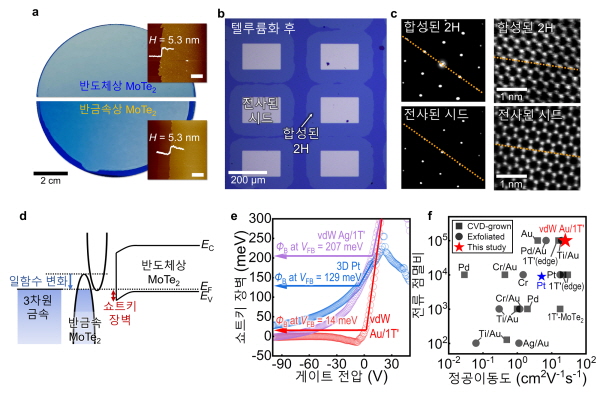2차원 물질 기반 고성능 p형 반도체 소자 제작기술이 개발돼 초미세화 기술이 적용될 차세대 상보형 금속산화 반도체(CMOS) 산업에 실질적으로 사용할 수 있을 것으로 기대된다.
UNIST, 4인치 대면적 소자 합성 기술 개발
이차원 전극 기반 차세대 산업에 적용될 것
2차원 물질 기반 고성능 p형 반도체 소자 제작기술이 개발돼 초미세화 기술이 적용될 차세대 상보형 금속산화 반도체(CMOS) 산업에 실질적으로 사용할 수 있을 것으로 기대된다.
UNIST(총장 이용훈)는 반도체 소재·부품 대학원 및 신소재공학과 권순용 교수팀이 UNIST 이종훈 교수팀과 몰리브덴 텔루륨화 화합물반도체(MoTe2)를 이용한 고성능의 p형 반도체 소자를 제작하는 데 성공했다고 24일 밝혔다.

▲대면적 몰리브덴 텔루륨화 화합물반도체(MoTe2)의 합성 및 3차원 금속/2차원 반금속 전극을 통한 고성능 p형 트랜지스터 소자 구현
CMOS는 p형 반도체와 n형 반도체가 상보적으로 접합된 소자다. 소비전력이 적은 반도체 소자로 PC, 스마트폰 등 일상적인 전자소자에 널리 사용된다. 실리콘 소재의 CMOS가 주로 사용되는데, 이온(ion)을 주입하는 공정을 통해 p형, n형 반도체 소자를 구현할 수 있다.
2차원 물질은 차세대 반도체로 각광받고 있는데, 두께가 매우 얇아 같은 공정 시 구조가 쉽게 파괴된다. 특히, 2차원 물질은 일반적인 3차원 금속전극을 형성할 때 계면에서 다양한 결함이 발생하는 문제점을 가지고 있다. 이를 해결하기 위한 다양한 연구들이 진행됐지만, 대부분의 연구는 ‘n형 반도체’에 집중돼있다.
연구팀은 반대로 ‘p형 반도체’ 중 몰리브덴 텔루륨화 화합물반도체(MoTe2)를 활용했다. 화학적 반응으로 박막을 만드는 화학기상증착법(CVD)을 통해 4인치의 큰 면적에서 소자를 합성할 수 있는 기술을 개발했다. 개발된 기술을 기반으로 2차원 반금속(semi-metal)에 3차원 금속을 증착했을 때 일함수가 조절되는 점을 활용해 고성능 p형 트랜지스터를 제작했다.
합성 온도와 시간을 조절해 4인치 크기의 반도체 박막을 고순도로 합성했다. 반금속 박막에 상변이를 돕는 반도체 시드(seed)를 옮긴 후, 500도 이하의 저온으로 합성하면 시드의 결정 모양대로 고품질의 반도체가 형성된다는 것을 확인했다.
제 1저자인 장소라 석·박통합과정 연구원은 “이번 연구에서 개발한 소자 제작 방법의 경우 논문에서 제시된 2차원 반도체뿐 아니라 다양한 2차원 소재에 적용 가능하다”며 “개발된 2차원 소재가 CMOS 산업에 적용돼 집적화 향상에 기여할 수 있기를 기대한다”고 설명했다.
이번 연구는 UNIST 권순용 교수(반도체소재부품대학원/신소재공학과, 공동교신저자), 이종훈 교수(신소재공학과, 공동교신저자)와 송승욱 박사(공동 제 1저자, 현 미국 펜실베니아대학교), 윤아람 박사(공동 제 1저자), 장소라 대학원생(공동 제 1저자) 등이 참여했다.

▲(왼쪽부터)권순용 교수, 이종훈 교수, 제 1저자 장소라 연구원, 제 1저자 윤아람 연구원, 제 1저자 송승욱 연구원

